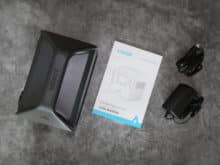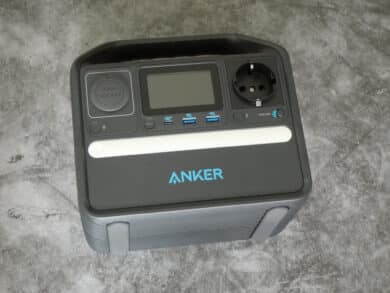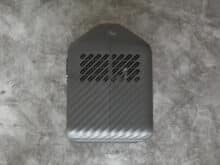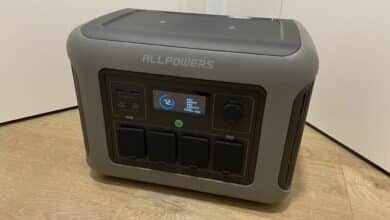
Powerstations have enjoyed great popularity for quite some time now, so the selection of manufacturers and models is constantly increasing. One of these manufacturers is Anker, which currently offers a total of eight models in the 5 and 7 series. With the Anker 521 PowerHouse, we take a look at the cheapest model of the lineup with less than 220 € in today’s test. Among other things, it has a battery capacity of 256 Wh, an AC socket and three USB outputs with a total output power of up to 398 W and can also be charged on the go with solar panels. Whether the Anker 521 PowerHouse can convince and where it differs from more expensive power stations, you can find out in our review.
Technical data of the Anker 521 PowerHouse
| Battery capacity | 256 Wh |
| Rated power | 20.000 mAh, 12.8 V |
| Battery cells | 20x 4,000 mAh LiFePO4 (lithium-ion) |
| Inputs | DC, USB-C |
| Input power | max. 65 W (DC, 11 – 28 V, max. 5.5 A), 60 W (USB-C) |
| Outputs | 1x AC, 1x car charger, 1x USB-C, 2x USB-A |
| AC output power | max. 200 W |
| Car charger output power | max. 120 W |
| USB-C output power | max. 60 W |
| USB-A output power | max. 12 W |
| Output power (total) | 398 W max |
| Operating temperature | 0 °C – 40 °C |
| Ambient temperature | 0 °C – 40 °C |
| Special features | drop-proof design, LED light bar, compatible with solar panels |
| Dimensions | 14.4 x 21.14 x 21.6 cm (L x W x H) |
| Weight | 3.7 kg |
| Color | Black |
| Scope of delivery | Powerstation, charger for Schuko-230 V socket, charging cable 12 V car cigarette lighter, operating instructions |
| Warranty | 5 years |
| Price | € 199.00 * |
Scope of delivery
The Anker 521 PowerHouse comes in a white and blue cardboard box with a carrying strap. On the front, you can find the product name, battery capacity, maximum output power, and plug type (EU, UK, or AU) next to a large picture of the power station. On the back, Anker lists the outputs and the corresponding power once again separately
The power station is well packaged and protected by polyethylene foam. In addition to the Anker 521 PowerHouse itself, a charger for a 230 V Schuko outlet, a charging cable for a 12 V car cigarette lighter and an instruction manual are included
Design and workmanship of the Anker 521 PowerHouse
The Anker 521 PowerHouse is rather plain in design and, aside from the blue font and white LED light bar on the front, is completely black. There is also a carrying handle on the top, which has finger recesses on its underside. Unfortunately, this is not foldable, which means you cannot place devices on the PowerStation for charging. The dimensions of 14.4 x 21.14 x 21.6 cm and the weight of 3.7 kg are similar to other manufacturers’ PowerStations with a similar capacity. This makes the 521 PowerHouse one of the more compact and lightweight powerstations, making it well suited for trips or camping.
Sophisticated design with smart display
The front features a display, five controls, and all of the power station’s ports. The smart display gives the most important information and shows the battery status, the outputs currently in use, the input and output power, and the remaining charge or run time. In addition, it also shows whether the energy-saving mode is active and warns of too high and too low temperatures. Directly below the display is the display button that activates it and the three USB ports. Furthermore, a car charger is located on the left front and an AC socket on the right. Both ports have to be activated manually before use, and a button is located underneath each. Under the AC socket is also a switch that activates or deactivates the energy-saving mode.
The upper half of the front is thus completely filled by the display and the ports. The layout looks well thought-out and the controls are also arranged sensibly so that the allocation is clear. A bit below the center is the white LED light bar, which runs across the entire width of the case. The on/off switch is integrated into the bar on the left.
On the back of the 521 PowerHouse, there is only a DC-7909 connector for charging the power station. The left and right sides of the case are ribbed and have vents for air and heat exchange, respectively. The underside is also ribbed, and two wide rubber linings ensure a secure stand.
The material quality and workmanship of the Anker 521 PowerHouse are convincing in the test. The plastic case appears insensitive and very robust, and the build quality is as good as usual.
Connection options and compatibility
The Anker 521 PowerHouse charges up to 65W via the DC-7909 connector. This is located on the back of the device. Further, the power station can also be charged with solar modules with an output voltage between 11 and 28 V via the same input. Anker itself offers a compatible solar module with the 625 Solar Panel, which charges the Powerstation in 4.1 hours in an ideal case. Both devices are also offered directly as a bundle. Alternatively, the Power Station can also be charged with up to 60 W via the USB-C port. If this is still not fast enough, the 521 PowerHouse can also be charged via the charger and USB-C at the same time.
An AC outlet with an output power of 200 W maximum and a car charger with an output power of 120 W maximum are available as outputs. While the car charger is protected by a cover, you have to do without it for the AC socket. Furthermore, there is one USB-C and two USB-A ports, via which up to 60 W and up to 18 W (max. 12 W per USB-A port) are available, respectively. The total output power is limited to 398 W.
Field test of the Anker 521 PowerHouse
The operation of the Anker 521 PowerHouse is very simple and intuitive. Plugged-in USB devices are automatically detected, so no further action is required here. The car charger and AC outlet, on the other hand, have to be turned on manually via the associated buttons. These also have an integrated LED that signals whether they are on or off. The bright display presents the most important information clearly and legibly. This includes the battery status, which is displayed symolically and as a percentage, the currently used outputs and the input and output power. Furthermore, the remaining charging or runtime, based on the current power, is also displayed in hours. For longer trips or camping, this makes it easy to keep track of the remaining capacity.
The LED light bar is easy to find even in low light due to its bright color, and the same applies to the button. The light of the LED light bar is warm and not very bright, it can rather be seen as a pleasant lighting for camping or also as emergency lighting. If you press the light button for 2 seconds, it starts flashing the light sign SOS.
Inside the Anker 521 PowerHouse are 20 cells with a total battery capacity of 256 Wh. The battery capacity is thus rather low, Anker’s other models 535 and 555 offer significantly more with 512 and 1,024 Wh, respectively, but are also correspondingly more expensive. Anker uses lithium iron phosphate cells (LiFePO4) in all models of the PowerHouse series, which are particularly durable and safe. After 3,000 charging cycles, they are said to still have a remaining capacity of 80% and thus enable use over many years. Furthermore, the cells are less sensitive to damage, and thermal runaway leading to fire or explosion can be virtually ruled out.
Charging and operation
To charge the Anker 521 PowerHouse, we used both the included charger and various USB-C chargers with an output power of 65 and 20 W, respectively. Charging was smooth in all cases and the display showed the appropriate input. This is also true for simultaneous charging via the DC-7909 port and USB-C; the input in this case was 125 and 85 W, respectively, which significantly reduced the charging time. These 125 W also represent the maximum.
In testing, we used the Anker 521 PowerHouse with various devices like our smartphone, a notebook, an Xbox console and to charge other devices. Charging the smartphone via USB-C was reliable at 18 W, while the notebook used the full 60 W. Other devices were also reliably charged individually and together, and the power station also shuts down in energy-saving mode afterwards. Since the output power of the AC outlet is only 200 W, its use is severely limited. Prospective buyers have to be aware of this before buying. This is enough to temporarily supply a notebook or even an economical desktop PC including monitor with power. Other devices, such as the Bluetti EB3A (review), offer much more for a moderate surcharge.
While the 521 PowerHouse remained very quiet under low load, the fan regularly turned up loud at an almost constant ~140 W (Xbox console operation) in the test. It is also annoying that it periodically turns on and off instead of running continuously and at a lower speed. Furthermore, fully protected connections for outdoor use would also be advantageous.
Anker 521 PowerHouse review: Conclusion
Anker offers an inexpensive entry-level device with the 521 PowerHouse, which is primarily convincing in terms of quality. Due to its compact dimensions and low weight, the Powerstation is very well suited for on-the-go use and has enough ports in addition to a bright display that shows a variety of information. The case of the Powerstation looks robust and is well manufactured. The interior also relies on particularly durable and safe LiFePO4 cells. This also results in a long manufacturer warranty of 5 years.
On the other hand, we are critical of the low output power of the ports. The AC socket can only be used to a very limited extent with a maximum output power of 200 W. The USB-C port can supply most devices with power without problems, but more and more devices already offer 100 instead of just 60 W. However, those who find the battery capacity of 256 Wh and the output power sufficient will get a good power station at an attractive price of under 220 € (as of August 30, 2023).
Anker 521 PowerHouse
Workmanship
Hardware
Performance
Value for money
84/100
Qualitatively good and compact power station with a sufficient number of ports, which, however, offer a rather low output power.
















